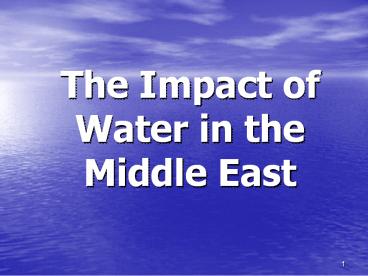The Impact of Water in the Middle East - PowerPoint PPT Presentation
1 / 32
Title:
The Impact of Water in the Middle East
Description:
The Impact of Water in the Middle East * Mention here how Israel and Jordan have conflicts over the use of the Jordan River that borders both countries. – PowerPoint PPT presentation
Number of Views:124
Avg rating:3.0/5.0
Title: The Impact of Water in the Middle East
1
The Impact of Water in the Middle East
2
Essential QuestionHow do water pollution and
the unequal distribution of water impact the
Middle East (Southwest Asia)?
- Standard SS7G6a. Explain how water pollution and
the unequal distribution of water impacts
irrigation and drinking water.
3
Activating StrategyScarcity of Water
What does scarcity mean? With a seat partner,
discuss another word for scarcity.
- https//www.youtube.com/watch?vGlWVDcdRVUA
watch first 3 minutes
4
Physical WaterScarcity Activityoptional
5
Interview Water Crisis in the Middle East
Tasksee resources
6
Where is the Middle East?
Lets examine a few maps of the Middle East in
relation to water supplies.
7
What is the difference between a Water-Scarce
Country and a Water-Stressed Country?
8
What is the difference between Physical Scarcity
and Economic Scarcity?
9
(No Transcript)
10
After looking at the maps, turn to a partner and
come up with a sentence to describe water in the
Middle East.Write your sentence on your notes
handout.
11
What do these graphs show?
Is this going to cause problems? Why?
12
The Middle East contains 5 of the worlds
population, but it has less than 1 of the
worlds freshwater resources.
13
- The Middle East is an arid (dry) region where
little rain falls - Rivers are the main source of water for drinking
and for power in many countries in the Middle East
14
Think of your physical features map, how many
rivers do you recall being in the Middle East
region we labeled?
If rivers are the main source of water, what is
part of the problem?
15
- Turkey, Iraq, Syria, Israel, Jordan and other
Middle East countries all depend on many of the
same water resources - The existing ground and surface water resources
are not enough to meet the needs of everyone
drinking water, irrigation of crops, domestic
uses, etc.
16
How is the scarcity of water related to the
unequal distribution of water?
- In which countries do you think water is unevenly
distributed?Why?
17
Another factor causing the unequal distribution
of water in the Middle East is the building of
dams.
18
- According to the International Rivers
Organization, Dams are used for the following - To generate electricity
- To supply water for agriculture, industries and
households - To control flooding
- To assist river navigation by providing regular
flows and drowning rapids. - Other reasons for building large dams include
reservoir fisheries and leisure activities such
as boating
19
Dams along the Tigris and Euphrates Rivers
20
What happens to the availability of water as it
flows from Turkey to the Persian Gulf?
21
Water Scarcity and Agriculture
- Agriculture uses about 85 percent of water in the
Middle East. It is common to misuse land by heavy
irrigation. - The overuse of water in agriculture is affecting
the already scarce water resources.
22
Water Scarcity and Agriculture
- Water scarcity and water use affect agriculture
(crop choice, growing seasons, and pests),
fisheries, forestry, and livestock (pastures and
pests). - These factors impact incomes and food security.
23
Distributed SummarizingOn your Middle East
Water Issues Graphic Organizer identify the
causes and effects of Unequal Water Distribution
of Water in the Middle East.
24
Unequal Distribution of Water
- Causes
- The Middle East is an arid (dry) region where
little rain falls - Rivers are the main source of water and there are
few rivers - The building of dams
25
Unequal Distribution of Water
- Effects
- The existing ground and surface water resources
are not enough to meet the needs of the growing
population drinking water, irrigation of crops - The building of dams along rivers make the rivers
less powerful and much smaller for countries down
the river
26
Water Pollution in the Middle East
27
(No Transcript)
28
Use Middle East Water Issues Graphic Organizer to
record the causes and effects of Water Pollution
in the Middle East.
29
Causes of Water Pollution in the Middle East
- Dams have reduced fresh water inflow that would
reduce pollution - Salt water mixing with fresh water (salination)
or soil degradation (ruin) - Depletion and contamination of underground and
surface water resources - Pollution from raw sewage, industrial waste, and
agricultural waste
30
Causes of Water Pollution in the Middle East
- Burning oil wells during the Persian Gulf War
created significant air pollution which disrupted
ecosystems, spoiled food webs, and contaminated
drinking water - Oil rigs cause pollution by leaking oil through
old equipment, illegal dumping, and accidental
spills
31
Effects of Water Pollution in the Middle East
- Economic Impact
- There is a limited supply of clean water for the
irrigation of crops - Polluted water can reduce the production of food
and pose health risks - Impact on the Population
- Polluted water is unsafe for drinking causing
health problems and in some cases death - Polluted water is unsafe for livestock and fish
which can be passed up the food chain
32
Summarizing Strategy 3-2-1
- Identify 3 causes of the unequal distribution of
water in the Middle East - Identify 2 causes of water pollution in the
Middle East - Identify 1 reason that the Middle Easts water
problems are getting worse































